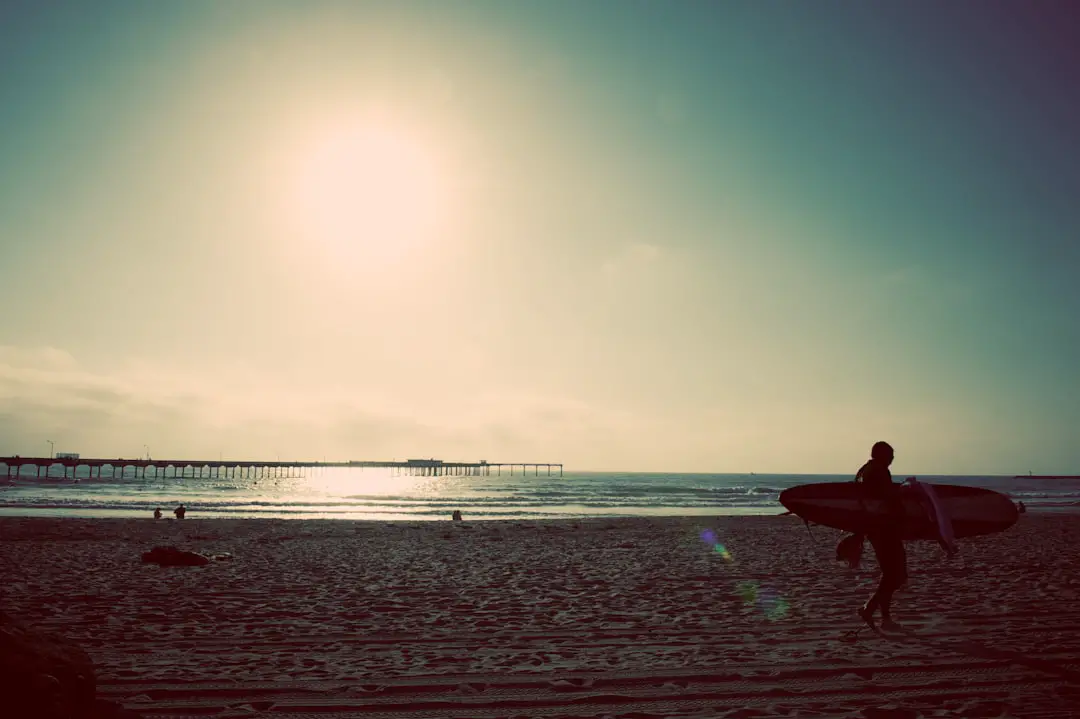Support our hydrofoil educational content for free when you purchase through links on our site. Learn more
What Does Foiling Feel Like? [2024] ✨
Have you ever wondered what it feels like to glide effortlessly above the water’s surface, defying gravity and experiencing a sensation like no other? Well, you’re in for a treat! In this comprehensive guide, we’ll dive deep into the world of foiling and explore the exhilarating feeling it offers. Get ready to discover the magic of hydrofoiling™ and why it has become one of the most exciting water sports around!
Quick Answer
Foiling feels like flying above the water, combining the thrill of surfing with the smoothness of gliding. It offers a unique and exhilarating experience that is often described as magical. With a hydrofoil attached to your board, you’ll experience a sensation of weightlessness as you effortlessly ride above the water’s surface. It’s a feeling that is hard to put into words but once you try it, you’ll be hooked! So, if you’re ready to take your water sports adventures to new heights, foiling is the way to go! ✈️
👉 CHECK PRICE on: Hydrofoil Boards | Hydrofoil Wings | Hydrofoil Packages
Quick Tips and Facts
Before we dive deeper into the world of foiling, here are some quick tips and interesting facts to get you started:
✅ Foiling combines the thrill of surfing with the smoothness of gliding above the water.
✅ Hydrofoiling™ is a relatively new water sport that has gained popularity in recent years.
✅ Foiling requires a specialized board with a hydrofoil attached underneath.
✅ The hydrofoil is a wing-like structure that lifts the board out of the water, reducing drag and allowing for a smoother ride.
✅ Foiling offers a unique sensation of weightlessness and freedom as you soar above the water’s surface.
✅ It’s important to start foiling in small, forgiving waves and gradually progress to larger swells.
✅ Safety is paramount when foiling, so always wear a helmet and impact vest, and be aware of your surroundings.
✅ Foiling can be challenging to learn, but with practice and the right equipment, anyone can master this incredible sport.
Now that you have a taste of what foiling is all about, let’s dive into the background and history of this thrilling water sport.
Background: The Rise of Foiling

Foiling, also known as hydrofoiling™, has taken the water sports world by storm in recent years. It has its roots in sailing, where hydrofoils were first used to lift boats out of the water and reduce drag. This innovation allowed boats to achieve higher speeds and smoother rides.
The concept of foiling was then adapted to other water sports, including surfing, kiteboarding, and stand-up paddleboarding. Today, foiling has become a sport of its own, with dedicated foiling boards and wings designed specifically for this exhilarating experience.
The Magic of Foiling: What Does It Feel Like?
So, what does foiling actually feel like? Imagine standing on a board, gliding across the water’s surface, and suddenly feeling a lift as the hydrofoil engages. You’re no longer riding on the water; you’re flying above it!
The feeling of foiling is often described as magical. It’s a combination of the thrill of surfing and the smoothness of gliding. As the hydrofoil lifts your board, you’ll experience a sensation of weightlessness and freedom. It’s like floating on air, with the water rushing beneath you.
The smoothness of foiling is truly remarkable. With the reduced drag provided by the hydrofoil, you’ll glide effortlessly across the water, even in less-than-ideal conditions. The bumps and chop that would normally slow you down are no longer a concern. Instead, you’ll be riding on a cushion of air, enjoying a smooth and stable ride.
But foiling isn’t just about the physical sensation; it’s also a mental and emotional experience. The feeling of flying above the water, defying gravity, and being one with the elements is incredibly empowering. It’s a moment of pure bliss and a connection with nature that is hard to replicate in any other water sport.
The Physics Behind Foiling
To truly appreciate the magic of foiling, it helps to understand the physics behind it. At its core, foiling relies on the principles of lift and drag.
When you’re riding a regular surfboard, you’re pushing against the water, creating drag that slows you down. But with a hydrofoil, things work differently. The hydrofoil’s wing-like shape generates lift as it moves through the water. This lift counteracts the drag, allowing the board to rise above the surface.
The hydrofoil is designed to create a pressure difference between the upper and lower surfaces of the wing. As water flows over the curved upper surface, it moves faster, creating lower pressure. At the same time, the water flowing beneath the wing moves slower, creating higher pressure. This pressure difference generates lift, lifting the board out of the water.
By adjusting the angle of the hydrofoil and the speed at which you’re riding, you can control the amount of lift and drag. This allows you to fine-tune your ride and adapt to different conditions, making foiling a versatile and exciting water sport.
How to Get Started with Foiling
Now that you have a good understanding of what foiling feels like, you’re probably eager to give it a try. Here are some tips to help you get started:
-
Choose the Right Equipment: Foiling requires specialized equipment, including a foiling board and a hydrofoil wing. It’s important to choose equipment that suits your skill level and the conditions you’ll be riding in. Consider factors such as board size, wing size, and construction materials.
-
Start in Small Waves: When learning to foil, it’s best to start in small, forgiving waves. This will allow you to get a feel for the board and the hydrofoil without the added challenge of larger swells. As you gain confidence and experience, you can gradually progress to larger waves.
-
Take Lessons: Foiling can be challenging to learn on your own, so consider taking lessons from a qualified instructor. They can teach you the proper techniques and help you progress faster. Lessons are also a great way to learn about safety and etiquette in the water.
-
Practice Towing: To get a feel for foiling before venturing into the waves, you can practice behind a boat or a personal watercraft. Towing allows you to focus on your balance and technique without the added challenge of catching waves. It’s a great way to build confidence and get comfortable on the board.
-
Safety First: When foiling, safety should always be your top priority. Wear a helmet and an impact vest to protect yourself in case of a fall. Be aware of your surroundings and stay away from crowded lineups. Always use a leash to keep your board close to you, and be mindful of other surfers and water users.
Remember, foiling takes time and practice to master. Don’t get discouraged if you don’t progress as quickly as you’d like. Enjoy the journey and embrace the learning process. With dedication and perseverance, you’ll soon be soaring above the water like a pro!
FAQ

Is foiling difficult?
Foiling can be challenging to learn, especially if you’re new to water sports. It requires a combination of balance, coordination, and wave-reading skills. However, with the right equipment, proper instruction, and plenty of practice, anyone can learn to foil. Start with small waves and gradually progress as you gain confidence and experience.
Read more about “How Hard is Wing Foiling? … 🏄♂️”
Is hydrofoiling easier than surfing?
Hydrofoiling offers a different experience than traditional surfing. While it may seem intimidating at first, many people find foiling easier than surfing once they get the hang of it. The reduced drag and smoothness of foiling make it easier to catch waves and maintain speed. However, it’s important to note that foiling still requires skill and practice to master.
Read more about “Is hydrofoiling easier than surfing?”
How hard is it to hydrofoil?
Hydrofoiling can be challenging, especially in the beginning. It requires a combination of balance, coordination, and wave-reading skills. Learning to control the hydrofoil and adjust your body position takes time and practice. However, with dedication and perseverance, you’ll gradually improve and become more comfortable on the foil.
Read more about “How hard is it to hydrofoil?”
What is the physics behind foiling?
Foiling relies on the principles of lift and drag. The hydrofoil’s wing-like shape generates lift as it moves through the water, allowing the board to rise above the surface. By adjusting the angle of the hydrofoil and the speed at which you’re riding, you can control the amount of lift and drag. This allows you to fine-tune your ride and adapt to different conditions.
Read more about “How Do Wing Foils Work? … 🌊🏄♂️”
Conclusion

In conclusion, foiling is an exhilarating water sport that offers a unique and magical experience. The feeling of flying above the water, defying gravity, and gliding effortlessly is truly something special. With the right equipment, practice, and dedication, anyone can learn to foil and enjoy this incredible sport.
If you’re ready to take your water sports adventures to new heights, we highly recommend giving foiling a try. Start with the right equipment, take lessons if needed, and practice in small waves to build your skills. Remember to prioritize safety and always be aware of your surroundings.
So, what are you waiting for? Dive into the world of foiling and experience the thrill of flying above the water. Get ready to embark on an unforgettable journey that will leave you craving more!
Recommended Links:
- 👉 CHECK PRICE on: Hydrofoil Boards | Hydrofoil Wings | Hydrofoil Packages
- Hydrofoil Basics
- Hydrofoil Equipment Reviews
- Hydrofoil Training
- Advanced Hydrofoiling Techniques
- Hydrofoil Safety Tips
- Can You Still Practice Surfing When It’s Flat? 10 Ways to Make the Most of Flat Water Surfing 2024
Reference Links:





